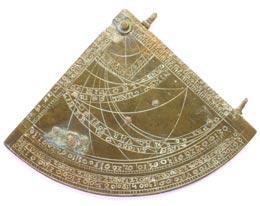
Posted on 04/03/2008 5:16:39 PM PDT by blam
Medieval calculator up for grabs

UK museum seeks cash to keep a rare astrolabe in public hands.
Philip Ball
The British Museum needs £350,000 to secure this astrolabe. The fate of a fourteenth-century pocket calculator is hanging in the balance between museum ownership and private sale.
The device is a brass astrolabe quadrant that opens a new window on the mathematical and astronomical literacy of the Middle Ages, experts say. It can tell the time from the position of the Sun, calculate the heights of tall objects, and work out the date of Easter.
Found in 2005, the instrument has captivated experts. Now they hope to keep it in public hands — not just to ensure future access to it for researchers, but because it is deemed an item of national cultural importance.
Saved from sale
The quadrant was found in excavations of a series of clay floors on the site of an old inn called the House of Agnes, just outside the city walls of Canterbury in Kent, UK, on the main road to London. It had lain there for over 600 years. Conceivably it was lost at the site by a merchant travelling to or from Canterbury, rather like Chaucer’s pilgrims.
The quadrant was initially put up for sale in 2007 by the auctioneers Bonhams, where it was expected to fetch £60,000–£100,000 (US$120,000–$200,000). But subsequent dealings led to an agreed sale at a price of about £350,000 (the buyer hasn't been publicly disclosed).
Because of the perceived cultural importance of the object, however, it was considered by the United Kingdom’s Reviewing Committee on the Export of Works of Art and Objects of Cultural Interest, which recommended to the government’s culture minister Margaret Hodge that granting of an export licence should be delayed until June 2008, giving time for the British Museum to try to buy the instrument for its forthcoming new Medieval Gallery. Such decisions are usually applied to works of fine art, not to scientific items, says Jim Bennett, director of the Museum of the History of Science in Oxford, who was an expert witness for the reviewing committee. The British Museum is now trying to raise the £350,000 needed to match the offer.
Sweet simplicity
Most surviving astrolabes are larger and more complex, including other functions such as astrological calculations. Their use tended to be highly specialized, confined mostly to academic settings. A quadrant astrolabe kept in the library of Merton College in Oxford, for example — one of the few other examples of this design — is considerably more elaborate and geared for academic use.
In contrast, the new quadrant is a simple, everyday item — the kind of thing a cleric or a merchant would have carried with them for convenient time-keeping. All the same, says Bennett, “you had to know some astronomy to work one of these devices”. He adds that it has design features that would appeal to medieval gadget freaks, such as a moveable eagle that indicates the date of Easter.
Most intriguingly of all, the Canterbury quadrant has been dated to the time of Geoffrey Chaucer: specifically to about 1388, just around when Chaucer began to write his Canterbury Tales. Chaucer was highly informed about astronomy and astrology, and in 1391 he wrote a treatise on the astrolabe that became the standard reference text for several centuries.
The existence of this simple, practical device sheds new light on Chaucer’s treatise: it supports the idea that Chaucer’s work was a piece of popular science writing, understandable to more than just the elite. “It suggests that this kind of knowledge wasn’t too arcane or academic,” says Bennett.
The British Museum has until June to come up with the money needed to buy the device and prevent a private sale. A curator from the museum was unable to comment on the status of the fund-raising while it is still in progress.
Very cool.

"Archaeologists in Somerset have uncovered evidence of a medieval gateway at Taunton Castle."
That is hilarious!
I wonder if replicas are available (with instructions, of course). I've a daughter who'd love same -- not to mention her dad.
Verily, by my trothe!
Shame on you. That was bad. And very funny!


Truly weird. The implication is that it is better to have the taxpayer foot the bill than to have this item in private hands. I get the impression museum people see the public purse as their personal piggy bank.
one of the classiest watches I ever saw was called an “astrolabe.”
And it runs Yellow Dog Linux!
The Most Clever Post Ever!
Years ago at the Chicago Museum of Science and Industry there was a display of a traveling collection of “compendiums”. These were pocket size, or nearly so, combinations of several navigational instruments: compass, sundial, astrolabe, magnifier, even entire maps, made of hinged brass or bronze sections. Fascinating!
PING!!
Don’t know about replicas...I remember picking up a few postcards of one at the Mariner’s museum in Virginia. They may have something in their store.
A movie!
bflr
The mechanism was incredibly complex and accurate. Also beautifully made with many wheels and gears and thousands of inscriptions in a small device you could carry in your hands. Whoever made that was definitely smarter than the average bear.
Disclaimer: Opinions posted on Free Republic are those of the individual posters and do not necessarily represent the opinion of Free Republic or its management. All materials posted herein are protected by copyright law and the exemption for fair use of copyrighted works.